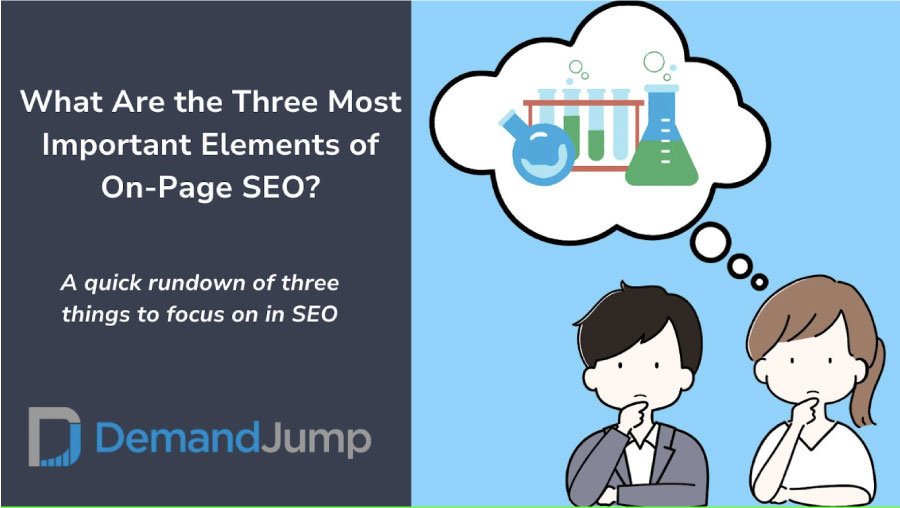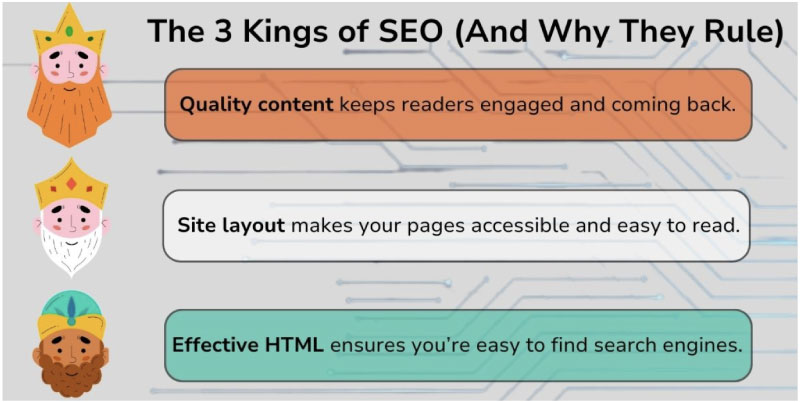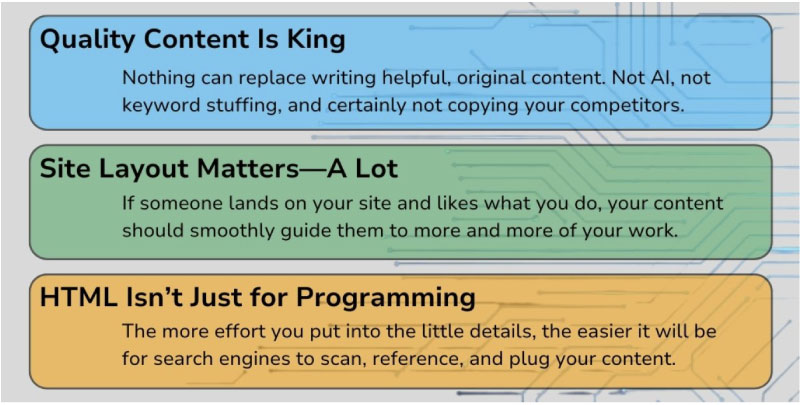What are the three most important elements in on page SEO?
March 19, 2024 •Tamzin Walters

When it comes to on-page content optimization, the three most important elements to consider are:
- Content Quality
- Site Layout
- HTML Usage
While there are many on-page SEO factors to keep track of, these three are your bread and butter. On-page SEO is all about visibility, accessibility, and capturing readers’ attention amidst the deluge of internet content—and having these three elements helps your chances greatly. Above all, quality content needs to be the core of your online presence, but intentionally crafting your site’s design and coding will also give you the extra edge to cut through the noise.
Looking to improve your online presence? DemandJump has you covered. Keep reading to learn more about the most important elements of SEO, and some simple on-page SEO techniques you can do today to help boost your rankings.

The 3 Elements of SEO (And How To Use Them)
Quality content, site layout, and HTML each play a crucial role in your on-page SEO efforts. Quality content keeps readers engaged, site layout keeps things accessible, and effective HTML makes you easy to find in the first place. We’ll cover each of these, but first it’s important to know what the overall goal is with our SEO efforts—to better understand why those three elements are so important to the goal.
Most marketers know why on-page SEO is important: it drives first impressions of your brand and makes you easier to find. But it’s very easy to lose sight of what you’re actually trying to accomplish with SEO (and marketing in general). So what can the main objectives of SEO show us about effective marketing? Above all, the most important thing your content (and SEO efforts) must do is provide value.
“Value” can be different depending on your audience and your brand goals. For example, value might be:
- A new idea or way of thinking about a topic
- An innovative, unique product or service
- Helpful information or opportunities for education
- Entertaining, compelling reads that spark thought
If your content isn’t aiming to do at least one of these things, you’re already starting from behind. No matter what your organization does or what your industry is, if you want a successful online presence then your content has to provide value to readers in some form. This doesn’t mean you need to be funny or come up with some entirely new concept, but you do need to consistently give readers what they’re searching for. Thankfully, the 3 elements of SEO—that is, content, layout, and HTML—help set the stage for that success.
Quality Content Is King
Nothing can replace writing helpful, original content. Not AI, not keyword stuffing, and certainly not copying your competitors. If you mimic what others are doing, jam a bunch of hot-button keywords into your copy, or use AI to spit out pages of platitudes, you’re actively practicing self-sabotage marketing.
- Instead of just using keywords because they’re trending, figure out what those keywords say about your target audience.
- Rather than relying on AI to do all the work, let AI help you with the tedious, time-consuming parts of content—so you focus on the actual ideas.
- Forget copying what the “best” are doing, and instead focus on what you do best—then copy that.
Most of the time, if a brand is successful it’s because they listen to their consumers, give their consumers what they want, and do so in a way that only they can. How can you do the same for your customers? As you do your keyword research, pay attention to the words your customers use. What language are they using? How much do they know about the topics they’re searching for, and what else might they be looking for?
Site Layout Matters—A Lot
Everyone knows the frustrating feeling of a web page that doesn’t load, or does so poorly because the site isn’t mobile friendly. Since most internet users are surfing the web on their phones, it’s critical that your page works on a variety of devices. But we’re not just talking about load times and configuration; site layout also has to do with interlinking your pages and improving your search rankings.
If someone lands on your site and likes what you do, your content should smoothly guide them to more and more of your work. Content strategies like Pillar-Based Marketing (PBM) do this well, making effective use of search behaviors to link multiple pieces of related content together in a way that makes sense for the reader.
HTML Isn’t Just for Programming
As it turns out, HTML code has a lot of uses for digital marketing:
- Images with alt text are far more likely to populate image searches.
- Using keywords as headers increases your chance to populate answer boxes on search engines.
- Good meta descriptions are helpful references for both readers and search engine crawlers.
Remember, SEO is not just about the readers—it’s about the search engine, too. The more effort you put into these little details, the easier it will be for search engines to scan, reference, and plug your content where your target audience can find you.

(Demand)Jumpstart Your Search Engine Optimization Strategies
What are the SEO tools you use to form your marketing strategy? At DemandJump, we empower our clients with the best keyword research tools available, creating plans based on consumer behaviors and how their target audiences are actually searching for things, in real-time. Combine this with Pillar-Based Marketing (PBM) techniques, content optimization strategies, and a team of quality writers, and you’ve got a winning strategy for making “Page One” a normal day at the office for your org.
If you’re ready to make the best of your marketing, come work with DemandJump. Try our platform for free, read through our customer testimonials, or contact us for advice on how to do an on-page SEO analysis for content. Page one is waiting for you—and so are we!
Featured Articles
Categories
- Attribution Tracking (13)
- Channel Optimization (11)
- Consumer Insights (68)
- Content Marketing (251)
- Data Science (8)
- Digital Marketing (6)
- Digital Transformation (26)
- Enterprise (10)
- Lead Generation (14)
- Market Intelligence (8)
- Marketing Analytics (39)
- Marketing Attribution (57)
- Marketing Management (153)
- Marketing Operations (86)
- Organic Search (222)
- Paid Search (52)
- Pillar-Based Marketing (63)
- Programmatic Advertising (9)
- SaaS Content (14)
- SaaS Marketing (29)
- Search Marketing (111)
- SEO Keyword Research (28)
- SEO Pillar (18)
- SEO Strategy (46)
- SMB (5)
- Website Content (12)


